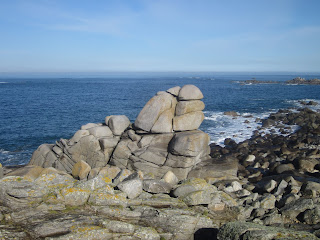The
iconography of St Pol (Sant Paol in Breton), one of the founding saints of Brittany St-Pol-de-Léon
St Pol
began his religious career in Wales Cornwall Brittany
This
focused purpose is suggested by his first landfall on Ouessant, a remote island
in the Atlantic off the north-west shore of Brittany
Further
place-names reflect the saint’s traditional journey eastwards across what is now
Léon, the northern part of Finistère: Lampaul-Plouarzel, Lampaul-Ploudalmezeau,
the chapel of Prat-Paol, Lampaul-Guimiliau and finally St-Pol-de-Léon. Here St
Pol is said to have had a positive interview with local count Withur (who may
have been a relation), and received land on the Ile de Batz, just off Roscoff.
Here he founded a monastery on the site of what later became a chapel to
St-Anne, still visible in ruins on the island now.
The Ile de
Batz was terrorised by a marauding dragon and the inhabitants approached St Pol
for help. He is said to have called the beast out of its lair, placed his
bishop’s stole around its neck, led it to the western edge of the island and
commanded the dragon to hurl itself into the sea. It obeyed. The place today is
called Toull ar Zarpant, Serpent’s Hole, and a striking rock formation marks
the bay where this remarkable event took place.
In the
village church, a medieval bishop’s stole is displayed in a glass case, echoing
the most memorable feature of the story, a wild beast led like a tame dog to
its death. The fabric has been tested and is very early, possibly 8th
century, alas too late for St Pol himself who died near the end of the 6th
century at the great age of 102.
He had
wanted to continue a quiet monastic life on the Ile de Batz, but was tricked
into becoming a bishop by Withur who sent him to Clovis Paris
The dragon
story overrides all other tales of St Pol’s miracle-working, such as healing
the blind and commanding the sea to respect a boundary he had set, the powers
that set him apart from other Christians in his group of settlers. It is surely
the detail of that wild monster behaving like a family pet that sticks in the
memory and makes the story curious. Another interesting detail, often
overlooked, is that the saint took a companion with him for this feat, a
certain knight from Cléder. The implication of a knight is of course a warrior
with a sword, which sounds suspiciously like an insurance policy or back-up
plan. Did St Pol want a witness? Or perhaps a muscle-man if things did not turn
out to his advantage. Did the islanders turn out to watch a potentially
thrilling contest or cower in their huts until the danger was past? An observed
miracle and a reported one are markedly different things.
If the
dragon, so vividly described in the Latin text of an early Vita of St
Pol, written by Wrmonoc, a monk at Landévennec in 884, symbolized pagan
religion, the worship of natural forces and elemental powers, it was perhaps
apt that it met its end on the western shore, a direction associated with death
and the Isles of the Blessed in Celtic mythology, here where the sea stretches
emptily and endlessly into the far distance. The bay is crammed with rocks of
all sizes today, dominated by the vaguely beast-shaped pile of giant stones at
a point exposed fully at low tide. The sea of course has resurrective potential
in pagan mythology, so the beast may not have been reluctant after all, and
needed little bidding to opt not for destruction but regeneration, and a
welcome release from the irritating goodness of Christian saints.













